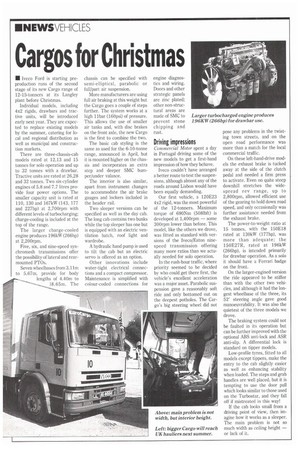Cargos for Christmas
Page 10

If you've noticed an error in this article please click here to report it so we can fix it.
• Iveco Ford is starting preproduction runs of the second stage of its new Cargo range of 12-15-tonners at its Langley plant before Christmas.
Individual models, including 4x2 rigids, drawbars and tractive units, will be introduced early next year. They are expected to replace existing models by the summer, catering for local and regional distribution as well as municipal and construction markets.
There are three-chassis-cab models rated at 12,13 and 15 tonnes for solo operation and up to 32 tonnes with a drawbar. Tractive units are rated at 26,28 and 32 tonnes. Two six-cylinder engines of 5.8 and 7.7 litres provide four power options. The smaller capacity unit is rated at 110, 130 and 167kW (143, 177 and 227hp) at 2,700rpm with different levels of turbocharging; charge-cooling is included at the top of the range.
The larger charge-cooled engine produces 196kW (266hp) at 2,200rpm.
Five, six, and nine-speed synchromesh transmissions offer the possibility of lateral and rearmounted PT Os.
Seven wheelbases from 3.11m to 5.67m, provide for body lengths of 4.40m to 18.65m. The chassis can be specified with semi-elliptical, parabolic or full/part air suspension.
More manufacturers are using full air braking at this weight but the Cargo goes a couple of steps further. The system works at a high llbar (160psi) of pressure. This allows the use of smaller air tanks and, with disc brakes on the front axle, the new Cargo is the first to combine the two.
The basic cab styling is the same as used for the 6-10-tonne range, announced in April, but it is mounted higher on the chassis and incorporates an extra step and deeper SMC bumper/under valance.
The interior is also similar, apart from instrument changes to accommodate the air brake gauges and lockers included in the header rail.
Two sleeper versions can be specified as well as the day cab. The long cab contains two bunks while the top sleeper has one but is equipped with an electric ventilation hatch, roof light and wardrobe.
A hydraulic hand pump is used to tilt the cab but an electric servo is offered as an option.
Other innovations include water-tight electrical connections and a compact compressor. Maintenance is simplified with colour-coded connections for engine diagnostics and wiring. Doors and other strategic panels are zinc plated; other non-structural areas are made of SMC to prevent stone chipping and rust.
Commercial Motor spent a day in Portugal driving some of the new models to get a first-hand impression of how they behave.
Iveco couldn't have arranged a better route to test the suspensions, although almost any of the roads around Lisbon would have been equally demanding.
Our first vehicle, a 120E23 4x2 rigid, was the most powerful of the 12-tonners. Maximum torque of 690Nm (5081bft) is developed at 1,400rpm — some 300rpm lower than before. This model, like the others we drove, was fitted as standard with versions of the Iveco/Eaton ninespeed transmission offering many more ratios than we actually needed for solo operation.
In the rush-hour traffic, where priority seemed to be decided by who could get there first, the vehicle's excellent acceleration was a major asset. Parabolic suspension gave a reasonably soft ride and only bottomed out on the deepest potholes. The Cargo's big steering wheel did not pose any problems in the twisting town streets, and on the open road performance was more than a match for the local commercial traffic.
On these left-hand-drive models the exhaust brake is tucked away at the side of the clutch pedal and needed a firm press to activate. Even on quite steep downhill stretches the widespread rev range, up to 2,800rpm, allowed efficient use of the gearing to hold down road speed, and only occasionally was further assistance needed from the exhaust brake.
The power-to-weight ratio at 15 tonnes, with the 150E18 rated at 130kW (177hp), was more than adequate; the 150E27R, rated at 196kW (266hp), is intended primarily for drawbar operation. As a solo it should have a Ferrari badge on the front.
On the larger-engined version the ride appeared to be stiffer than with the other two vehicles, and although it had the longest wheelbase of the three, its 52° steering angle gave good manoeuvrability. It was also the quietest of the three models we drove.
The braking system could not be faulted in its operation but can be further improved with the optional ABS anti-lock and ASR anti-slip. A differential lock is standard on tipper models.
Low-profile tyres, fitted to all models except tippers, make the entry to the cab slightly easier as well as enhancing stability when loaded. The steps and grab handles are well placed, but it is tempting to use the door pull which looks similar to those used on the Turbostar, and they fall off if mistreated in this way!
If the cab looks small from a driving point of view, then imagine how it works as a sleeper. The main problem is not so much width as ceiling height — or lack of it.




















































































